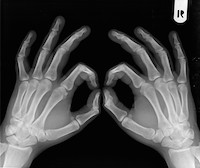 So, what really is the difference between Rheumatoid Arthritis and Osteoarthritis?
So, what really is the difference between Rheumatoid Arthritis and Osteoarthritis?
The term “Arthritis”, literally means inflamed joint, and for physios working in private practice it is one of the most common patient presentations we deal with. Although Rheumatoid Arthritis (RA) and Osteoarthritis (OA) both affect our joints they are very different conditions in terms of their origin and cause and how we manage them.
The biggest difference between these conditions is that RA is an autoimmune disease, whereas OA is a degenerative disease. In the case of RA what this means is that the body’s immune system begins to attack the joints. The main target for RA is the synovium (this is the soft lining that encloses the majority of joints in the body), and the immune system incorrectly sees this as a threat similar to how it would see a bacteria or virus, and then does it’s best to get rid of it.
As a result of this, fluid accumulates around the joints causing pain, stiffness, tenderness and inflammation. RA is also a symmetrical disease in that it affects both sides of the body simultaneously. It generally begins in the smaller joints such as the fingers and can eventually spread into the larger joints as well such as the hips, shoulders and ankles. Because RA is an autoimmune disease it can affect the entire body, not just the joints.
For this reason, early signs of RA can include low-grade fever, muscle aches and excessive fatigue. People in advanced stages of RA may notice hard lumps underneath the skin near the joints. These lumps are called rheumatoid nodules and can be very painful and restrict normal movement.
OA on the other hand is a degenerative joint disease, and the most common form of arthritis in the general population. OA causes a breaking down or wearing out of the hard protective cartilage that covers the bone ends in a joint. As the cartilage wears out it allows the underlying softer bone ends to rub together which accounts for significant pain and inflammation.
OA does not involve the immune system at all like RA does, and doesn’t tend to affect both sides of the body at once. OA will generally target the large weight bearing joints, like the hip or knee on one side of the body. People with OA will not experience full body symptoms like RA, and symptoms are limited solely to the joints themselves.
Regardless of whether someone has RA or OA, the symptoms they feel in the affected joints will be similar. These symptoms include pain and stiffness, with decreased movement, and at times heat and swelling in the joints.
The process and progression of both OA and RA in the body currently cannot be stopped and there is a lot of research being done to find a cure for both. The primary goal of treatment is to give advice on how to manage the pain and stiffness and to maintain what the sufferer can currently do.
A multidisciplinary approach works best with treatment with the Doctor prescribing pain relief and anti-inflammatories, and in the case of RA autoimmune inhibiting drugs, and the physiotherapist working on strengthening and mobility around the joints, as well as helping pain control.
Even though Arthritis can be painful and limiting, there is much we can do to maintain lifestyle and function. If you think you have arthritis see your Doctor or Physio as soon as you can to get going with treatment. Don’t leave it too long – it’s never too early to get started!









Join the Discussion
Type out your comment here:
You must be logged in to post a comment.